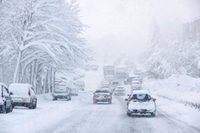Northwest drivers still claim to drive safely, comfortably in snow
 |
SEATTLE--Dec. 11, 2013: Are you better at navigating slick, snowy roads than your fellow drivers? The latest poll from PEMCO Insurance affirms an emerging trend: despite visible chaos on the streets when it snows, four out of five Northwest drivers consider themselves on par with or more skilled at navigating icy roads than their peers.
In time for December's plunging temperatures and the possibility of snow this winter, a recent poll by the Seattle-based insurer asked Northwest drivers about their own skill and comfort in inclement conditions, along with what they observe from other cars on the road.
Though it may come as a surprise – especially if you've seen news footage following the season's first snowstorm showing cars slowly sliding and piling up on city streets – the PEMCO Insurance Northwest Poll finds that more than half of Northwest drivers (54 percent) in Washington and the Portland, Ore., metropolitan area say they're comfortable driving on snowy and icy roads.
The poll also reveals that just 37 percent of Washington drivers take the basic winter safety precaution of carrying chains in their cars. In Portland, residents are more likely to carry chains as a precaution – 48 percent keep them in their vehicle in case of a winter emergency.
"Despite what we may see on the streets, drivers around here definitely seem to have plenty of self-confidence – perhaps showing they think their skills and comfort driving in snow keep them from needing tire chains," said PEMCO spokesperson, Jon Osterberg.
But whether drivers carry chains may not matter if the owner doesn't know how to put them on. About half of Northwest residents – 53 percent – never have installed tire chains on their vehicle.
"Drivers should practice putting on chains before the snow falls," said Osterberg. "Don't simply toss new chains into the trunk until they're really needed. You're better off practicing at home in daylight than doing it with numb fingers on the side of the road with cars spinning around you, perhaps after dark."
The polls shows that while tire chains may not be a top priority, many Northwest drivers do travel in winter with extra clothing, blankets, water, or a first-aid kit. But less than one-third carry flares or extra food, and just 20 percent keep a shovel in case of emergencies.
While many say they're comfortable driving in snowy or icy conditions, collision and accident data from the Washington State Department of Transportation (WSDOT) show that driving in poor conditions, even with chains on your tires, is far from safe. According to WSDOT, most accidents occur in fall and winter.
Washington's stark differences in climate and topography between the east and west side of the state may influence driver confidence. Sixty-four percent of Eastern Washington drivers say they're comfortable driving in winter conditions, compared to 53 percent of those in Western Washington.
"That makes sense, with their experience driving in a colder climate," said Osterberg. "My own perception was that the east-west disparity would be even greater, based on the traffic snarls we see in snowstorms west of the Cascades."
Regardless of where you live, Northwest drivers should be especially cautious during the first snowy days of the year, which are substantially more dangerous than those that follow, according to a study in the American Journal of Public Health.
Many would agree that's wise advice. About one in 10 Washington drivers have suffered the unfortunate fate of abandoning their car in a snowstorm, according to the PEMCO poll.
Beyond the inconvenience, abandoned cars are particularly troubling because they're obstacles and sometimes roadblocks on snowy roads, arterials, and even freeways.
Any time snow or ice is a factor, PEMCO recommends staying off the road if feasible. Of those polled who had to abandon a car in a snowstorm, many said they followed PEMCO's best practices:
Try to get as far off the traveled roadway as you safely can. Turn on your flashers, and leave them on. A dead battery is better than causing an accident for which you could be held responsible. Set out flares to warn other drivers, if you can safely do so. Make a reasoned judgment about whether to stay with the vehicle and call for help, or to strike out on your own. Some factors to consider are your health, weather-appropriate clothing, distance to the nearest help, and the likelihood of your vehicle being hit while you're inside it. Leave a note in the window with your contact information. That improves your chance of hearing from someone who hits your vehicle, or from the authorities. Take your most valuable items with you. Be sure to remove documents containing sensitive personal information about you or your family. Set the emergency brake and lock the doors. Professional towing companies know how to safely tow your vehicle.
To learn more about the PEMCO Insurance Northwest Poll and to view a summary of the results, visit PEMCO Poll, where the public is invited to participate in an informal version of the poll and see how their own responses compare with those collected by FBK Research of Seattle in November 2013.


